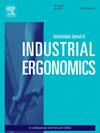Investigating affective and emotional responses to motion in 4D movies
IF 3
2区 工程技术
Q2 ENGINEERING, INDUSTRIAL
International Journal of Industrial Ergonomics
Pub Date : 2025-09-12
DOI:10.1016/j.ergon.2025.103810
引用次数: 0
Abstract
In the film industry, physical effects that enhance the sense of reality are known as four dimensional (4D) effects, which aim to intensify viewers’ affective and emotional experiences. Despite their growing use, empirical research on how 4D effects influence emotional responses remains limited. This study focuses on motion, one of the most commonly applied 4D effects, and investigates how single roll motion influences affective and emotional responses. Participants viewed short movie clips with and without a single roll motion while their physiological responses such as heart rate (HR), skin conductance level (SCL), and facial electromyograph (EMG) were recorded. They also reported the intensities of felt emotions and perceived emotions and affects. The results revealed that single roll motion significantly increased HR and SCL. The subjective evaluation showed enhanced levels of surprise and arousal (felt emotions), as well as increased perceived dangerous and strong (perceived affects). These findings provide empirical evidence that single roll motion can enhance affective and emotional responses in 4D experiences. The study contributes to a deeper understanding of motion and emotion in 4D experience.
研究4D电影对运动的情感和情绪反应
在电影行业,增强真实感的物理效果被称为四维(4D)效果,旨在加强观众的情感和情感体验。尽管它们的使用越来越多,但关于4D效应如何影响情绪反应的实证研究仍然有限。本研究的重点是运动,最常用的4D效果之一,并探讨单滚运动如何影响情感和情绪反应。参与者观看了有或没有滚动动作的短片,同时记录了他们的生理反应,如心率(HR)、皮肤电导水平(SCL)和面部肌电图(EMG)。他们还报告了感觉情绪和感知情绪和影响的强度。结果表明,单辊运动显著提高了HR和SCL。主观评价显示惊讶和觉醒(感觉情绪)的水平增强,以及感知到的危险和强烈(感知到的影响)的水平增加。这些发现提供了经验证据,证明单滚运动可以增强4D体验中的情感和情绪反应。该研究有助于更深入地理解4D体验中的运动和情感。
本文章由计算机程序翻译,如有差异,请以英文原文为准。
求助全文
约1分钟内获得全文
求助全文
来源期刊
CiteScore
6.40
自引率
12.90%
发文量
110
审稿时长
56 days
期刊介绍:
The journal publishes original contributions that add to our understanding of the role of humans in today systems and the interactions thereof with various system components. The journal typically covers the following areas: industrial and occupational ergonomics, design of systems, tools and equipment, human performance measurement and modeling, human productivity, humans in technologically complex systems, and safety. The focus of the articles includes basic theoretical advances, applications, case studies, new methodologies and procedures; and empirical studies.

 求助内容:
求助内容: 应助结果提醒方式:
应助结果提醒方式:


